Influence of Saturated Organic Matter on the Accuracy of In-Situ Measurements Recorded with a Nuclear Moisture and Density Gauge
doi: 10.5552/crojfe.2021.762
volume: 42, issue:
pp: 12
- Author(s):
-
- Labelle Eric R.
- Jaeger Dirk
- Article category:
- Original scientific paper
- Keywords:
- forest soils, soil bulk density, machine traffic, theta probe, soil cores, non-destructive measurements, soil monitoring
Abstract
HTML
The impact of machines on forest soils is regularly assessed and quantified using absolute bulk density, which is most frequently obtained by soil cores. However, to allow for repeated measurements at the exact same locations, non-destructive devices are increasingly being used to determine soil bulk density and moisture content in field studies. An example of such a device is a nuclear moisture and density gauge (NMDG), originally designed as a control measurement for soil bulk density and moisture content in geotechnical applications. Unlike road construction or foundation projects that use mineral soil or gravel, forest soils have complex structures and the presence of organic matter, which can skew moisture and density readings from a NMDG. To gain further knowledge in this respect, we performed controlled tests in a sandbox to quantify the influence of varying amounts of saturated organic matter (3, 5, 10, and 15%) mixed with mineral soil in different layers (0–5, 0–10, 0–20 and 0–40 cm) on the accuracy of soil moisture content obtained by a NMDG and soil theta probe at varying depths. Main results illustrated that the presence of saturated organic matter per se was not problematic but moisture content overestimations and related underestimation of dry bulk density occurred when the tested measurement depth was below the created organic layer. Since forest soils often exhibit higher organic matter contents in the upper horizon, correction factors are suggested to minimize the moisture content variations between NMDG and reference method. With the use of correction factors, NMDG can present a non-destructive, fast, and accurate method of measuring soil moisture and bulk density in forestry applications.
Influence of Saturated Organic Matter on the Accuracy of In-Situ Measurements Recorded with a Nuclear Moisture and Density Gauge
Eric R. Labelle, Dirk Jaeger
Abstract
The impact of machines on forest soils is regularly assessed and quantified using absolute bulk density, which is most frequently obtained by soil cores. However, to allow for repeated measurements at the exact same locations, non-destructive devices are increasingly being used to determine soil bulk density and moisture content in field studies. An example of such a device is a nuclear moisture and density gauge (NMDG), originally designed as a control measurement for soil bulk density and moisture content in geotechnical applications. Unlike road construction or foundation projects that use mineral soil or gravel, forest soils have complex structures and the presence of organic matter, which can skew moisture and density readings from a NMDG. To gain further knowledge in this respect, we performed controlled tests in a sandbox to quantify the influence of varying amounts of saturated organic matter (3, 5, 10, and 15%) mixed with mineral soil in different layers (0–5, 0–10, 0–20 and 0–40 cm) on the accuracy of soil moisture content obtained by a NMDG and soil theta probe at varying depths. Main results illustrated that the presence of saturated organic matter per se was not problematic but moisture content overestimations and related underestimation of dry bulk density occurred when the tested measurement depth was below the created organic layer. Since forest soils often exhibit higher organic matter contents in the upper horizon, correction factors are suggested to minimize the moisture content variations between NMDG and reference method. With the use of correction factors, NMDG can present a non-destructive, fast, and accurate method of measuring soil moisture and bulk density in forestry applications.
Keywords: forest soils, soil bulk density, machine traffic, theta probe, soil cores, non-destructive measurements, soil monitoring
1. Introduction
Machine-induced soil disturbances, in particular soil compaction within a forestry context, is normally assessed by soil bulk density collected by metal tubes of known volume that are inserted into the soil and then extracted to obtain the mass of the material. This method remains labor intensive and destructive thereby not allowing for repeated assessments of soil physical properties from the same sample point (Jansson 1999). Hence, this renders temporal monitoring of soil properties from exactly the same location impossible. Other instruments such as in-place soil density with sand-cone and nuclear moisture and density gauge (NMDG) are also available to measure in-situ soil properties. In addition to allowing in-place and non-destructive assessment of soil bulk density and moisture content (Hao et al. 2008), NMDGs also permit multi-depth measurements from the same drill hole, allow for fast data acquisition and instantaneous results, and offer the possibility of performing repeated measurements at identical locations (Al-Shammary et al. 2018, Labelle et al. 2019). Despite these sizeable advantages, it is important to consider that NMDGs were originally designed to assess soil bulk density and moisture content on geotechnical projects (foundations and road construction) where the substrate being tested is usually mineral soil or gravel layers with minimal amounts of organic matter. During the past four decades, the use of NMDGs in the field of forestry has increased steadily (Steele et al. 1983, Corns 1988, Page-Dumroese et al. 1999, Labelle and Jaeger 2011, Jurgensen et al. 2018, Labelle et al. 2019). One of the most noticeable differences between geotechnical and forest sites lies with the presence of organic matter (litter and roots), which has a potential to affect the accuracy of the NMDG measurements, in particular moisture readings, and thus, the calculated dry bulk density values, because the hydrogen contained in the organic matter contributes to the increase of moisture readings.
In order to gain further knowledge on the applicability of using NMDGs in a forestry environment with the presence of organic matter, this research aimed to:
Assess the influence of varying saturated organic content both in terms of quantity and thickness on the:
Þ accuracy of soil moisture measurements as recorded by a NMDG and a theta probe
Þ accuracy of soil dry bulk density measurements as recorded by a NMDG.
2. Material and Methods
2.1 Experimental Design and Procedure
Due to the interactions of numerous variables (i.e., soil moisture content, soil texture, organic matter, roots, rocks, surrounding vegetation, brush mat, etc.) linked to data recording in forest stands, controlled testing was performed in a laboratory at the University of New Brunswick, Canada.
To quantify the influence of organic matter on the accuracy of a NMDG and a soil moisture theta probe, combinations of different mixtures of homogeneous mineral soil and peat moss (97% organic matter) placed in different layers were tested within a confined area (sandbox). In particular, our study tested four levels of organic content (3, 5, 10 and 15%) applied in four different layers (0–5, 0–10, 0–20 and 0–40 cm) within a test sandbox (Fig. 1). In this research, zero refers to the surface of the soil. For each of those treatment combinations, properties (soil moisture with theta probe and soil bulk density and moisture with soil cores and NMDG) were assessed at four different depths (5, 10, 20 and 30 cm) and each combination replicated once. This yielded 128 measurements (4 organic matter contents × 4 layers × 4 depths × 2 tests) for each assessment method (soil cores, NMDG, theta probe), thus equaling 384 measurements.

Fig. 1 Side-view schematic of the sandbox indicating the four tested layers of sand and organic material mixtures
The sandbox (140 cm in length by 80 cm in width and 70 cm in height), constructed from structural lumber, was designed to enable in-place soil bulk density and moisture measurements and was equipped with detachable sidewalls on the front side to allow quick excavation of the material between tests. Furthermore, the sandbox was divided in two equally sized compartments to permit simultaneous testing of two different treatments. Horizontal reference lines were drawn on the inside perimeter of each compartment at every 10 cm on the vertical to facilitate the compaction process. Sand (99.3% mineral) as used in concrete mixtures was chosen for consistency between tests.
To obtain comparable conditions between tests, mineral sand and organic matter were prepared at fixed moisture contents by adding the required amount of water. Targets were set at 5% moisture for the mineral sand and saturation for the organic matter. Therefore, moisture content of the saturated organic material averaged 664.5% (percent of dry mass) with a standard error of ± 4.1% between all tests. Since organic material has high water absorption capacity, it was important to increase its moisture level so that it is more in line with organic material in the upper horizons of forest soils. To reach the desired organic content mixture the necessary amount of saturated organic material was mixed with mineral sand (at 5% moisture content) with a portable electric mixer (capacity of 0.1 m3). For consistency, all samples were mixed for a duration of eight minutes. After mixing, the sand or the sand and organic mixture was transferred from the mixer into one of the two sandbox compartments. To obtain a uniform density throughout the vertical and horizontal profile, sand or mixture of sand and organic material was added in four 10 cm vertical increments. At each fill layer, a steel rammer weighing 7220 g with a base area of 144 cm2 (nominal compaction energy of 63 kJ/m3), was dropped vertically and in a perpendicular angle to the soil surface from a height of 10 cm. Maintaining a constant height of fall assured comparable compaction energy for equal compaction of the sand. The rammer was moved systematically until the entire surface area was compacted by providing two blows over the surface of each layer. This compaction method was repeated for each 10 cm layer.
2.2 Instruments and Operating Principles
2.2.1 Soil Cores
Due to their frequency of use and reliability, soil cores were used as the reference method to collect samples to determine soil bulk density and moisture content (Solgi et al. 2018). A thinned-wall steel cylinder (inside diameter of 5.33 cm, length of 3.53 cm and volume of 78.76 cm3) was inserted horizontally into the soil at the target depth with a hammer. The core and corresponding sample were then retrieved from the soil by careful extraction and the ends of the core were trimmed flush to the edge of the cylinder. Core samples were then extracted from the cylinder weighed and oven-dried at 105 °C until constant mass was reached to determine the gravimetric moisture content and dry density by relating the dry mass of the sample to the volume of the core.
2.2.2 Nuclear Moisture and Density Gauge
A Humboldt 5001 EZ NMDG was used as a non-destructive method of assessing soil moisture and dry bulk density (Fig. 2). The NMDG automatically computes a variety of parameters, including direct readouts of wet bulk density, dry bulk density, gravimetric moisture content, percent of moisture, percent of compaction (Proctor or Marshall), void ratio, and air voids. For this research, focus was directed at dry bulk density as well as gravimetric moisture content of the soil. The density measurement is based on the attenuation of gamma radiation (Cesium-137), due to photoelectric absorption, which is related to the electron density of materials (Humboldt Scientific 2012). This indicates the mass density of materials with a chemical composition similar to the crust of the earth (Humboldt Scientific 2012). This parameter can be recorded in backscatter mode or in direct transmission mode where the source rod is lowered into the soil (Ball et al. 1998, Canadian Nuclear Safety Commission 2015). The entirety of soil bulk density readings for this project was recorded in direct transmission mode. The gamma source, located at the end of the source rod can be lowered up to a 30 cm depth in 5 cm increments. The sensor (gamma detector) that collects the backscattering of gamma radiation is located at the bottom of the NMDG, which is always placed in full contact on the ground.
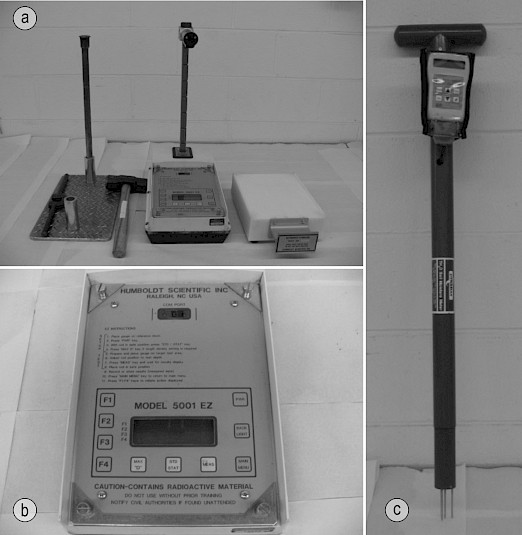
Fig. 2 a) NMDG with reference plate, drill rod, hammer, drill rod extractor, and reference standard block, b) Control panel and display screen of NMDG, and c) Theta probe soil moisture meter
As for the moisture content (gravimetric), its measurement is based on the thermalization (or slowing down) of fast neutron (Americium-241) radiation, which is a function of the hydrogen content of the materials tested. Since neutrons have no charge, they pass through atoms quite readily and unless they collide with a nucleus of an atom, there is little or no loss of energy. A significant loss of energy occurs only when neutrons collide with a low mass nucleus such as that of hydrogen. Both neutron source and sensor are located at the bottom of the nuclear gauge; therefore, moisture content can only be recorded in the backscatter mode (Humboldt Scientific 2012). Because of this, moisture measurements only represent the top 135 mm of material, with the main influence being centered at a depth of approximately 60 mm (Winter and Clarke 2002). The exact depth of this zone is dependent on the density of the material and the quantity of hydrogen ions (Fig. 3) (Winter and Clarke 2002). In general, the radius (r) of the sphere of influence of the probe can be estimated by Equation 1.
 (1)
(1)
Where:
Θ percent of soil gravimetric moisture content (Álvarez-Benedí and Muňoz-Carpena 2005).
Furthermore, the sphere of influence can vary according to the following factors:
Þ it increases as the soil dries because the hydrogen concentration decreases, so that the probability of collision is smaller and therefore fast neutrons can travel further from the source
Þ it is smaller in fine textured soils because of their water holding capacities, and thus the probability of collision is higher
Þ if there are layers with large differences in water content due to changes in soil physical properties, the sphere of influence can have a distorted shape (Muňoz-Carpena et al. edited by Álvarez-Benedí and Muňoz-Carpena 2005).
Instruments using radiation to perform measurements are subject to decay of the source (2.3% per year for Cesium-137), drift of the detectors due to leakage and absorption of quench gas, and long-time drift of the electronics, which makes a reference standard necessary (Humboldt Scientific 2012). A reference standard count was performed at the beginning of each day of testing. To achieve this, a reference standard block was used to provide a four-minute long standard count to account for the natural decay of the isotopes (Humboldt Scientific 2012). To be able to decrease errors, calibrations were performed as a ratio to a standard measurement. The actual moisture count for the standard obtained by the NMDG during the four-minute count was calibrated by the known and constant moisture content of the standard and the density count was likewise related to the known density of the standard and the shielding material of the base of the NMDG. In order to compute a moisture count from the reference standard block, the NMDG measured the hydrogen content. As for the density standard, it was determined primarily by the shielding material in the base of the NMDG and only slightly by the reference standard block. Calibration errors within 1% for density and 2% for moisture counts were deemed acceptable (Humboldt Scientific 2012).
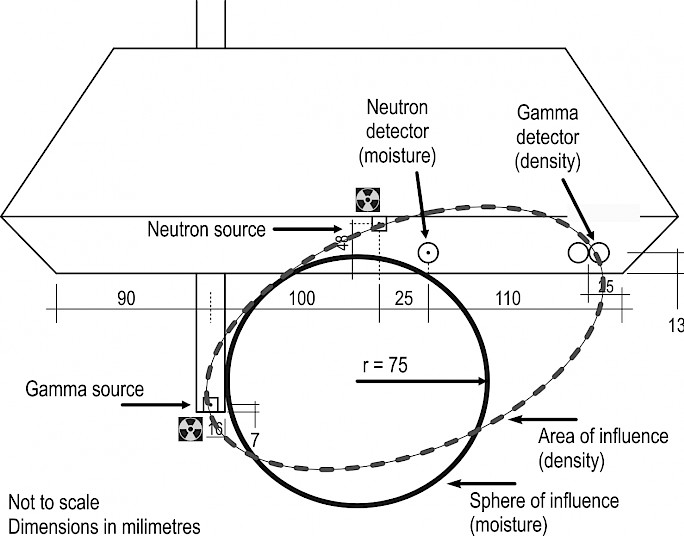
Fig. 3 Side view of a typical nuclear moisture-density gauge, showing the location of radioactive sources and detectors for moisture and density measurements (adapted from Winter and Clarke 2002)
2.2.3 Soil Moisture Theta Probe
A HH2 soil theta probe was used for comparative measurement of volumetric soil moisture content. The device is based on amplitude domain reflectometry and generates a 100 MHz sinusoidal signal, which is applied to a specially designed internal transmission line that extends into the soil by means of an array of four stainless steel rods (Fig. 2c). The three outer rods are connected to the instrument ground and form an electrical shield around the central signal rod (Miller and Gaskin 1999). The impedance of this array, which varies with the impedance found in the soil, has two components – the apparent dielectric constant and the ionic conductivity. The frequency of the signal was chosen to minimize the effect of ionic conductivity, so that changes in the transmission line impedance are almost solely based on the apparent dielectric constant of the soil. Since the dielectric constant of water (~81) is substantially higher than that of soil (3 to 5) and air (1), it is determined primarily by its corresponding water content (Dynamax 2017). Given that the length of the stainless steel rods is 6 cm, the theta probe records layer-wise volumetric water content. The area of measurement is within a cylinder of 4 cm diameter and 6 cm length (approximately 75 cm3) surrounding the central rod. As a NMDG records gravimetric water content, equation 2 was used to convert the theta probe’s volumetric water content to gravimetric to allow for direct comparisons. Bulk density results obtained from soil cores were used as input in equation 2 (Dynamax 2017).
 (2)
(2)
Where:
θGgravimetric water content of the soil
θVvolumetric water content of the soil
ρwdensity of water, = 1
ρsbulk density of the soil sample, = Ms/Vs
Msmass of soil solids
Wsvolume of solids
2.3 Measurement Procedure
Once compaction within the sandbox was complete, the guide plate, drill rod and a hammer were used to create a 35 cm deep hole within the sand. The NMDG was positioned over the newly created hole and the source rod lowered to 30 cm. A one-minute measurement count was done, after which subsequent measurements were performed in order to assess soil bulk density and soil moisture at 20, 10, and 5 cm depths from the sand surface. The exact position of the NMDG relative to the frame of the sandbox compartment was measured following the completion of the readings to ensure that the other two test methods would sample the same area. After the NMDG readings, the gauge was removed and the theta probe was inserted into the soil to record volumetric moisture content. The procedure with the NMDG and theta probe was repeated at another location within the sandbox. Afterwards, a soil core was collected at each layer and for each position. The readings provided by the NMDG were cross-referenced with the ones acquired with a soil core sampler to develop a correlation between moisture readings obtained with the nuclear gauge and the organic matter content of the soil. After a set of readings was complete, the entire compartment of the box was emptied to enable mixing of a new sample.
Moisture results from the soil cores were also used to establish a correction factor (KVAL) of the NMDG and to reassess the corrected data in terms of goodness of fit with the reference method. For this analysis, linear regressions and figures were produced using the statistical software Minitab. In addition, the theta probe was also used to determine volumetric water content at every depth to act as an additional reference of the water content obtained with the nuclear gauge.
3. Results
3.1 Accuracy of Soil Moisture and Dry Bulk Density
When plotting NMDG and theta probe moisture contents in function of reference moisture content determined by oven-drying the material extracted from the soil cores, coefficient of determination of the linear regression was 0.59 and 0.93 for the NMDG and theta probe, respectively (Fig. 4). High variability in moisture content between NMDG and reference values is mostly concentrated in the low moisture content range (0–10%). The vast majority (90%) of these data points were collected at lower depths of 20 and 30 cm and were linked to treatments where the thickness of the organic material mixture was limited to the upper 10 cm layer (additional information in section 3.2). Because of the strong correlation to reference values and ease of operation, the theta probe is a suitable method for cross-referencing moisture contents in the field. Moisture readings at different depths (5, 10, 20, and 30 cm) were studied in the sandbox since excavation was easy to perform. However, only the top 6 cm of soil can be assessed in the field if long-term monitoring is targeted.
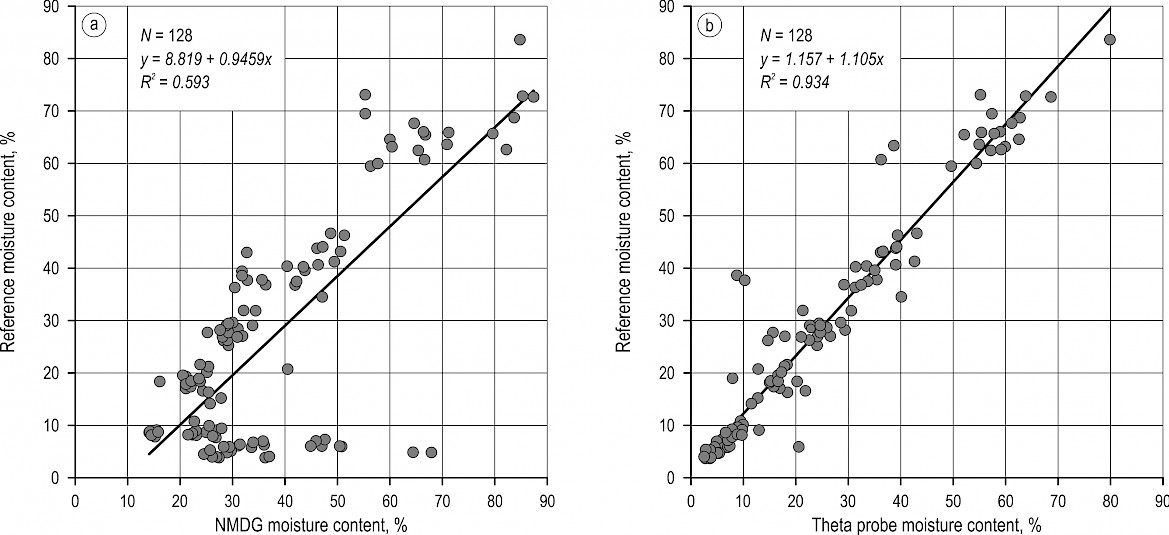
Fig. 4 Relationship between reference (soil cores) soil moisture content and a) moisture content from NMDG, b) moisture content from theta probe
As the amount of organic material present in the sand increased, dry bulk density of the material generally decreased for both soil cores and NMDG results (Table 1). Aside from a few occasions, the NMDG seemed to underestimate dry bulk density at depths located below the layer of organic mixture. Conversely, the NMDG tended to overestimate dry bulk density within the layer of organic mixture. Agreement between NMDG and soil cores was improved when the entire sandbox (0–40 cm layer) was subjected to organic matter mixtures. In this instance, variations in NMDG dry bulk density ranged from an underestimation of 2.1% to an overestimation of 14.7% as compared to soil cores
Table 1 Dry bulk density results between reference soil cores and nuclear moisture and density gauge presented by organic matter content scenario, layer, and measurement depth
|
Organic content % |
Measurement depth cm |
Layer, cm |
|||||||||||
|
0–5 |
0–10 |
0–20 |
0–40 |
||||||||||
|
REFa |
NMDGb |
Diff.c |
REF |
NMDG |
Diff. |
REF |
NMDG |
Diff. |
REF |
NMDG |
Diff. |
||
|
g/cm3 |
% |
g/cm3 |
% |
g/cm3 |
% |
g/cm3 |
% |
||||||
|
3 |
5 |
1.138 |
1.346 |
18.3 |
1.146 |
1.187 |
3.6 |
1.234 |
1.214 |
–1.7 |
1.214 |
1.189 |
–2.1 |
|
10 |
1.504 |
1.403 |
–6.7 |
1.324 |
1.234 |
–6.8 |
1.312 |
1.251 |
–4.6 |
1.253 |
1.236 |
–1.4 |
|
|
20 |
1.527 |
1.451 |
–5.0 |
1.530 |
1.295 |
–15.4 |
1.469 |
1.314 |
–10.5 |
1.220 |
1.259 |
3.2 |
|
|
30 |
1.518 |
1.470 |
–3.2 |
1.488 |
1.333 |
–10.4 |
1.500 |
1.338 |
–10.8 |
1.264 |
1.267 |
0.2 |
|
|
5 |
5 |
1.343 |
1.205 |
–10.3 |
0.971 |
1.160 |
19.4 |
1.034 |
1.095 |
5.9 |
1.049 |
1.030 |
–1.8 |
|
10 |
1.496 |
1.284 |
–14.1 |
1.294 |
1.232 |
–4.7 |
1.036 |
1.110 |
7.2 |
1.007 |
1.071 |
6.4 |
|
|
20 |
1.551 |
1.338 |
–13.8 |
1.501 |
1.287 |
–14.3 |
1.521 |
1.198 |
–21.3 |
1.040 |
1.088 |
4.7 |
|
|
30 |
1.518 |
1.378 |
–9.2 |
1.497 |
1.312 |
–12.4 |
1.554 |
1.242 |
–20.0 |
1.028 |
1.119 |
8.8 |
|
|
10 |
5 |
0.788 |
0.925 |
17.4 |
0.782 |
0.883 |
13.0 |
0.819 |
0.858 |
4.7 |
0.853 |
0.835 |
–2.1 |
|
10 |
1.477 |
1.044 |
–29.3 |
0.758 |
0.991 |
30.7 |
0.809 |
0.859 |
6.2 |
0.848 |
0.867 |
2.3 |
|
|
20 |
1.512 |
1.165 |
–22.9 |
1.507 |
1.138 |
–24.5 |
0.951 |
0.910 |
–4.4 |
0.857 |
0.880 |
2.7 |
|
|
30 |
1.473 |
1.217 |
–17.4 |
1.526 |
1.201 |
–21.3 |
1.502 |
1.020 |
–32.1 |
0.878 |
0.897 |
2.1 |
|
|
15 |
5 |
0.501 |
0.677 |
35.2 |
0.590 |
0.655 |
11.0 |
0.521 |
0.572 |
9.8 |
0.574 |
0.636 |
10.8 |
|
10 |
1.487 |
0.792 |
–46.7 |
0.617 |
0.697 |
13.1 |
0.545 |
0.589 |
8.1 |
0.599 |
0.678 |
13.3 |
|
|
20 |
1.469 |
1.022 |
–30.4 |
1.467 |
0.884 |
–39.7 |
0.606 |
0.618 |
2.1 |
0.639 |
0.732 |
14.7 |
|
|
30 |
1.458 |
1.115 |
–23.5 |
1.493 |
0.991 |
–33.6 |
1.516 |
0.759 |
–49.9 |
0.648 |
0.739 |
14.1 |
|
|
a Reference value obtained from soil cores b Nuclear moisture and density gauge c Percent difference between NMDG and reference, with reference taken as benchmark measure |
|||||||||||||
For an all-inclusive analysis, a single regression between soil dry bulk density obtained from the NMDG and reference was calculated for the entire dataset (128 measurements) and provided a decent agreement (R2=0.61, Fig. 5). However, when looking at the results from their respective measurement depths, most of the high deviations were linked to 10, 20 and 30 cm depths. The higher underestimations of dry bulk density by the NMDG as compared to the standard reference were not observed for the 5 cm measurements.

Fig. 5 Relationship between reference and NMDG soil dry bulk density according to measurement depth
3.2 Influence of Organic Matter Content on Soil Moisture Measurements
Aside from a few occasions, the NMDG tended to overestimate soil moisture content when compared to the reference, whereas the theta probe was more prone to a slight underestimation (Fig. 6). Regardless of the amount of organic material added, the NMDG provided more accurate results (closer to reference values) when the depth of the measurement did not exceed the thickness of the organic matter content layer mixture. Highest overestimations were detected when the NMDG assessed soil moisture content below the organic layer being tested. For example, when testing a 0–5 cm organic layer at 15% composition, the NMDG provided high overestimations of soil moisture content at 10, 20 and 30 cm depths as compared to both the theta probe and the reference. However, when a 0–40 cm layer was tested (regardless of percentage of organic matter), moisture measurements obtained by the NMDG were in rather close agreement to the reference.
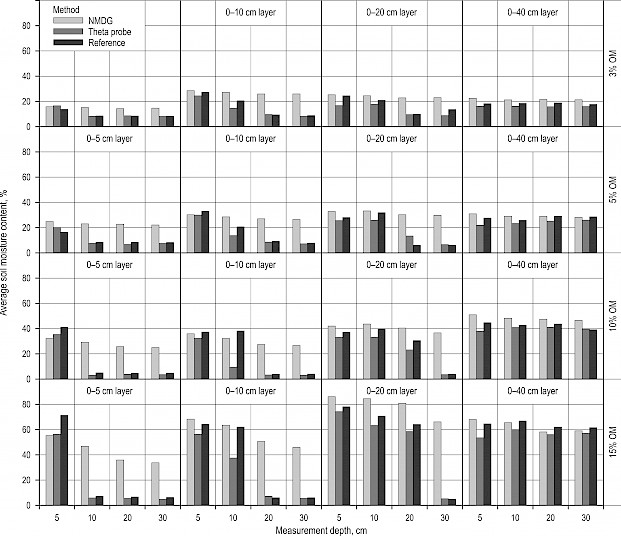
Fig. 6 Influence of organic matter content (presented on the right of the figure) and thickness of layer on average soil moisture content measured with NMDG, theta probe and reference (soil cores) at 5, 10, 20 and 30 cm depths
For ease of understanding, a relative difference in soil moisture content was calculated, while using the reference moisture as benchmark (Fig. 7). In this case, the reference was set at 1 and any increase beyond 1 implied an overestimation and a decrease signaled an underestimation of moisture content. In general, the NMDG agreed well with the reference when the depth of measurement equaled the thickness of the organic layer. Beyond this thickness, up to a 10-fold increase in soil moisture could be observed at the 30 cm measurement depth for the 0–20 cm layer at 15% organics. The most stable results were observed for the 0–40 cm layer, regardless of the amount of organic matter content.
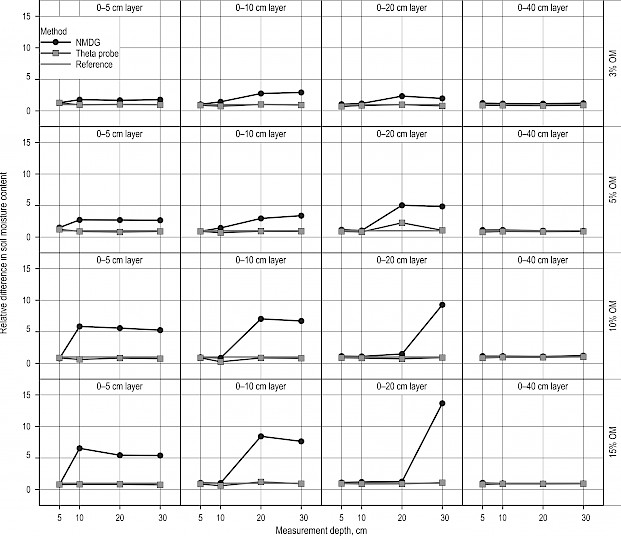
Fig. 7 Influence of organic matter content (presented on the right of the figure) and thickness of layer on the relative difference in soil moisture content for the NMDG and theta probe as compared to the benchmark obtained from the reference (soil cores)
3.3 Correction Factor
The moisture readings of the NMDG directly impact the internally calculated dry bulk density of the material. For this reason, it is necessary to obtain a good understanding of the accuracy of the devices used to measure both wet bulk density and moisture. Since the NMDG tends to overestimate soil moisture, a correction factor can be calculated and stored in the gauge to automatically compute adjusted moisture contents. This correction factor referred to as KVAL can be applied to moisture measurements to account for hydrogen in the material that is not water or hydrogen in water, e.g., membrane water, which is not removed by normal oven-drying methods (Humboldt Scientific 2012). If the moisture content obtained with the NMDG is higher than that of the oven, then a negative KVAL is obtained (Humboldt Scientific 2012) as per Equation 3.
 (3)
(3)
The NMDG had a general tendency to overestimate moisture contents compared to the actual oven-dried results based on the sandbox experiment (R2=0.59, Fig. 8). This is especially true at depths ranging from 10 to 30 cm. When corrected values are applied to the initial NMDG moisture contents using equation 3, the relationship between the corrected NMDG and reference moisture content become very strong (R2=0.82). Applying the correction factor greatly reduced the number of outliers and improved the agreement between the two variables. The majority (80%) of these outliers corresponded to measurements recorded at lower depths (20 or 30 cm). An individual correction factor was applied to all scenarios analyzed in the sandbox experiment. The results indicate that applying a correction value to moisture content readings for the 10, 20, and 30 cm depths of soil greatly improved the accuracy of the NMDG, in particular at lower depths e.g., 20 and 30 cm. Soil dry bulk density is calculated based on the wet bulk density and moisture content of the soil; therefore, the correction factor applied to the moisture readings will also influence the wet and dry bulk densities obtained from the NMDG. Any soil water content reduction when applying a correction factor results in an increase of soil wet and dry bulk densities.
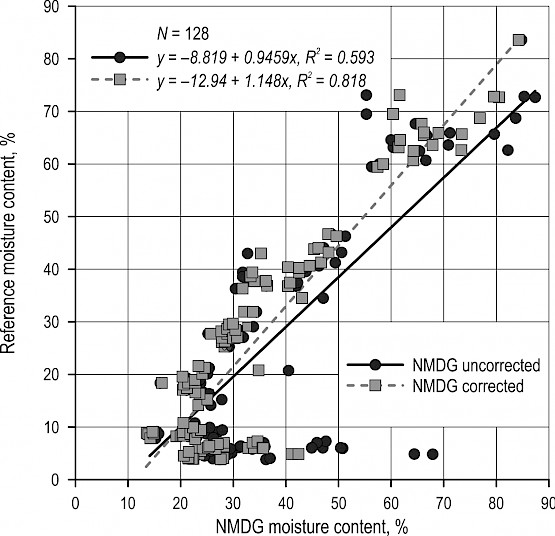
Fig. 8 Agreement between NMDG uncorrected and corrected moisture contents (KVAL) and reference moisture content (soil cores)
4. Discussion
As illustrated in the results section and supported by the studies conducted by Wood et al. (2004), Labelle and Jaeger (2011) and Labelle et al. (2019), soil bulk density obtained with a NMDG in a forestry context is a promising technique. However, using this device has certain disadvantages and limitations. NMDGs require nuclear safety training, expose the user to nuclear radiation and can be expensive to purchase (approx. 15 000 EUR), which could explain in part why their use within a forestry context remains rather limited as compared to soil cores. When considering soil bulk density measurements of mechanized forest operations, one of the most important limitation is the influence of soil consolidation and soil displacement within the study area between pre- and post-harvest readings. Since NMDGs record layer density instead of point density, compaction and rutting caused by the equipment can affect post-harvest readings by assessing material from a lower soil depth compared to initial pre-harvest readings. Since soil bulk density tends to increase with depth, vertical variation of density and moisture readings (position of NMDG on soil surface) could bias the true rate of compaction.
NMDGs record layer density unlike a soil core sampler, which records point density. Even though the source rod could be adjusted at different depth intervals, the NMDG does not compute specific point densities. This is due to the backscatter of gamma radiation, where 95% of the reading is influenced by the soil located above the source, and the remaining 5% comes from below the source (Parsons 1992). For example, if the source rod is lowered to Z3, the density computed by the NMDG will be composed of 95% of the material located above Z3 (P1 to P3) and 5% will be of the material lower than Z3 (Fig. 9). Since density of naturally developed soils increases with depth, densities assessed in lower horizons by the NMDG are somewhat underestimated since they are influenced by the density of the material above them.
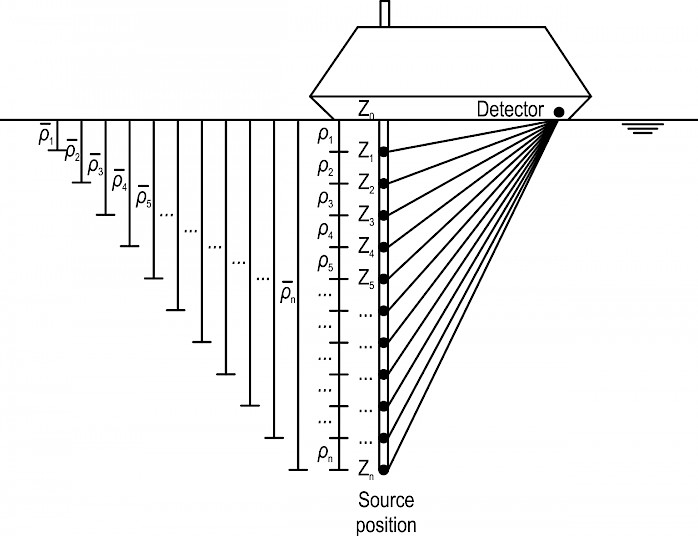
Fig. 9 Nuclear moisture-density gauge operation showing point density (Z) and layer density (Ρ) depths (Adapted from Winter and Clarke 2002)
The strong correlation between results obtained from the theta probe soil moisture sensor and those from the reference (soil cores) make this instrument a robust cross-referencing alternative at shallow depths (0–6 cm). In field applications, a theta probe could also be used at lower depths, i.e. 10, 20, and 30 cm but would require excavation, thus disturbing the study area.
NMDGs have been used for many decades in various industrial settings. They were first developed for quality control of sub-grade and base material compaction during road construction (Randrup and Lichter 2001). There are fundamental differences (organic matter content, roots, higher water content, etc.) in materials found in a forest floor compared to the ones used in road construction. Regardless of their extensive use in industry, the use of nuclear gauges in forested soils has not been thoroughly studied. Wood et al. (2004) compared three different sampling techniques of forest soils but put forth few explanations with regard to moisture content readings provided by the Humboldt 5001EZ nuclear density gauge, the same model as used in this study.
Results obtained in our case study showed that the NMDG overestimated soil water content when this parameter varied suddenly within a soil profile (Fig. 4a). An abrupt change in soil water content is often associated with a change in the amount of organic matter present due to its water holding capacity. The method readily available to correct such overestimations of the water content was to apply a correction factor to density and moisture readings obtained with the NMDG. Applying such a correction factor increased the accuracy of the nuclear gauge by 10 to 15% for 10 to 30 cm depths compared to the reference (oven-drying). Another work procedure that can be applied in the field is to remove the upper organic layer prior to setting the NMDG, thereby creating a small pad directly on mineral soil where the bottom of the NMDG can rest.
5. Conclusions
The NMDG tested was not particularly sensitive to the amount of organic matter present in the soil but rather to where the organic layer was located in reference to the measurement point. This finding is especially important for forest soils where higher amounts of organic content are often present in the upper horizon. When using NMDG in layered soils, special attention should be given to correcting the data obtained by NMDG with the use of reference samples collected from the same test site. The use of the correction value (KVAL) greatly improved the accuracy of moisture and density results obtained by the NMDG and should be considered in future studies. Despite this shortfall, NMDGs continue to show promise as a non-destructive in-situ soil moisture and density assessment tool within a forestry context.
Based on the findings of this study:
Þ it is recommended to remove the organic top layer before assessing soil bulk density and soil moisture by a NMDG when used within a forest setting
Þ rather than relying on the absolute values, the NMDG is definitely a useful device for relative comparison of the effects of different treatments.
Acknowledgements
The authors wish to thank two anonymous reviewers for their comments for improvement. We also extend gratitude to Mr. Aaron Arnold and Mrs. Hélène Rioux-Labelle for assistance provided during testing. Funding was provided by the New Brunswick Innovation Foundation. Special thanks are also due to the Faculty of Forestry and Environmental Management at the University of New Brunswick for providing laboratory space required for testing and the Faculty of Engineering for the use of the concrete mixer. Authors are also thankful for the support of the Lafarge Inc. group for providing the necessary testing material.
6. References
Al-Shammary, A.A.G., Kouzani, A.Z., Kaynak, A., Khoo, S.Y., Norton, M., Gates, W., 2018: Soil bulk density estimation methods: A review. Pedosphere 28(4): 581–596. https://doi.org/10.1016/S1002-0160(18)60034-7
Álvarez-Benedí, J., Muňoz-Carpena, R., 2005: Soil-water-solute process characterization. An integrated approach. CRC Press, Washington DC, 172 p.
ASTM D 2974 – 00, 2000: Standard test methods for moisture, ash, and organic matter of peat and other organic soils. American Society for Testing and Materials, 332–334.
Ball, A.J., Solomon, C.J., Zarnecki, J.C., 1998: The response of gamma backscatter density gauges to spatial inhomogeneity – An extension of the single scattering model. Nuclear Instruments and Methods in Physics Research B. 140(3–4): 449–462. https://doi.org/10.1016/S0168-583X(98)00188-8
Canadian Nuclear Safety Commission, 2015: How portable gauges work. URL: https://nuclearsafety.gc.ca/eng/resources/news-room/feature-articles/how-portable-gauges-work.cfm (Last accessed: June 20, 2019).
Corns, I.G.W., 1988: Compaction by forestry equipment and effects on coniferous seedling growth on four soils in the Alberta foothills. Canadian Journal of Forest Research 18(1): 75–84. https://doi.org/10.1139/x88-012
Dynamax, 2017: User manual for the ML3x Theta Probe soil moisture sensor. URL: http://dynamax.com/images/uploads/papers/ML3_Manual.pdf. (Last accessed: July 21, 2019).
Hao, X., Ball, B.C., Culley, J.L.B., Carter, M.R., Parkin, G.W., 2008: Soil density and Porosity, Chapter 57 in Soil sampling and methods of analysis. Second edition (Eds: Carter, M.R. and Gregorich, E.G.), Canadian Society of Soil Science, 1224 p.
Humboldt Scientific, 2012: User guide for the HS-5001EZ series nuclear moisture-density gauge, 72 p.
Jansson, J-K., 1999: Comparison of density and water content determination using soil cores and a dual probe density gauge. International Journal of Forest Engineering 10(2): 83–90.
Jurgensen, M.F., Page-Dumroese, D.S., Brown, R.E., Tirocke, J.M., Miller, C.A., Pickens, J.B., Wang, M., 2018: Estimating carbon and nitrogen pools in a forest soil: influence of soil bulk density methods and rock content. Soil Science Society of America Journal 81(6): 1689–1696. https://doi.org/10.2136/sssaj2017.02.0069
Labelle, E.R., Jaeger, D., 2011: Soil compaction caused by cut-to-length forest operations and possible short-term natural rehabilitation of soil density. Soil Science Society of America Journal 75(6): 2314–2329. https://doi.org/10.2136/sssaj2011.0109
Labelle, E.R., Poltorak, B.J., Jaeger, D., 2019: The role of brush mats in mitigating machine-induced soil disturbances: an assessment using absolute and relative soil bulk density and penetration resistance. Canadian Journal of Forest Research 49(2): 164–178. https://doi.org/10.1139/cjfr-2018-0324
Miller, J.D., Gaskin, G.J., 1999: ThetaProbe ML2x, Principles of operation and applications. MLURI Technical note, Second edition.
Page-Dumroese, D.S., Brown, R.E., Jurgensen, M.F., Mroz, G.D., 1999: Comparison of methods for determining bulk densities of rocky forest soils. Soil Science Society of America Journal 63(2): 379–383. https://doi.org/10.2136/sssaj1999.03615995006300020016x
Parsons, A.W., 1992: Compaction of soils and granular materials: A review of research performed at the Transport Research Laboratory. London HMSO, 323 p.
Randrup, T.B., Lichter, J.M., 2001: Measuring soil compaction on construction sites: A review of surface nuclear gauges and penetrometers. Journal of Arboriculture 27(3): 109–117.
Solgi, A., Naghdi, R., Labelle, E.R., Tsioras, P.A., Salehi, A., 2018: Comparison of sampling methods used to evaluate forest soil bulk density. Croatian Journal of Forest Enginbeering 39(2): 247–254.
Steele, J.G., Koger, J.L., Trouse, A.C., Sirois, D.L., 1983: Core versus nuclear gauge methods of determining soil bulk density and moisture content. U.S. Forest Service Research Note, S0-285: 1–6.
Winter, M.G., Clarke, B.G., 2002: Methods for determining representative density-depth profiles using nuclear density gauges. Geotechnique 52(7): 519–525. https://doi.org/10.1680/geot.2002.52.7.519
Wood, M.J., Douglas, R.A., Sands, R., 2004: A comparison of three methods for measuring the density of a forest soil in New Zealand. International Journal of Forest Engineering 15(1): 71–80. https://doi.org/10.1080/14942119.2004.10702491
© 2020 by the authors. Submitted for possible open access publication under the
terms and conditions of the Creative Commons Attribution (CC BY) license (http://creativecommons.org/licenses/by/4.0/).
Authors’ addresses:
Assoc. Prof. Eric R. Labelle, PhD *
e-mail: eric.labelle@sbf.ulaval.ca
Université Laval
Department of Wood and Forest Sciences
2405 Rue de la Terrasse
Québec G1V 0A6
CANADA
Prof. Dirk Jaeger, PhD
e-mail: dirk.jaeger@uni-goettingen.de
Georg-August-Universität Göttingen
Faculty of Forest Sciences and Forest Ecology Burckhardt-Institute
Department of Forest Work Science and Engineering
Büsgenweg 4
37077 Göttingen
GERMANY
* Corresponding author
Received: October 10, 2019
Accepted: June 20, 2020
Preliminary note

